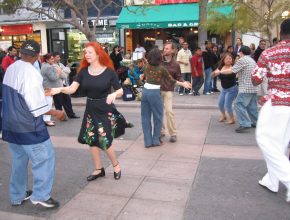lived space
the lived space overlays physical space; it is the space of inhabitants, of ‘users’, of writers and artists, who experience it directly, filtering the experience through emotions, memories and symbolic meanings, shaping a world of organic relations born of real encounters. It is produced if allowing individuals to manifest their particular spatial experiences and urban aspirations, and through sensibility and imagination may be transformed in an attempt to appropriate it.
the sensible
“The sensible? It is neither the apparent, nor the phenomenal, but the present.” (Lefebvre 2004, p.21). It is the direct experience of a realm that is accessed through the knowledge of the body and its non-rational soul, by both sensory and intellectual perception.
 dancing on the Third Street Promenade in Santa Monica, California, January 2007
dancing on the Third Street Promenade in Santa Monica, California, January 2007
rhythmanalyses
Henri Lefebvre made an attempt to develop a theory of rhythms, as he considered rhythms and everyday life the concrete modalities of social time: “Without claiming to change life, but by fully reinstating the sensible in consciousness and in thought, he [the rhythmanalyst] would accomplish a tiny part of the revolutionary transformation of this world and this society in decline. Without any declared political position.” (Lefebvre 2004, p.26). Rhythmanalysis was coined by Gaston Bachelard in The Psychoanalysis of Fire, (1964 [1949]); he borrowed the term from the 1930s Portuguese writer Lucio Alberto Pinheiro dos Santos.
Rhythms are relative and enter into a perpetual interaction, thus rhythmanalyses are necessarily comparative. [link to paper]. The waves on the sea surface is a physical example of rhythms’ complexity that extends from temporal elements to movement and memory, or to take an example from the urban life, the succession within rituals intervening in the daily time. There are linear rhythms defined by the repetition of the same phenomena that mostly belong to the modern life such as routines, successions, chronologies, predetermined encounters, a social and civil time. At the same time, there are cyclical rhythms that have a determined frequency and new beginnings similarly to the cosmic rhythms, among them are the seasonal changes, the succession of day and night, rituals, alternating manifestations of social organization and the like.